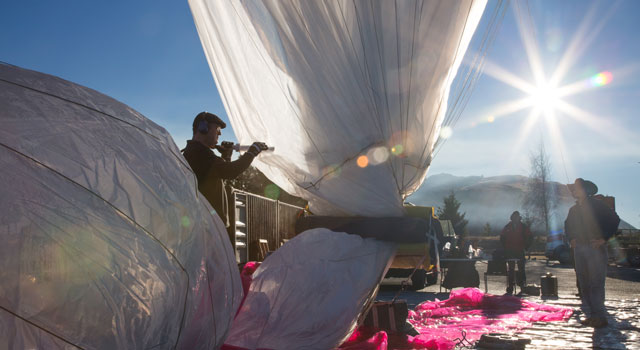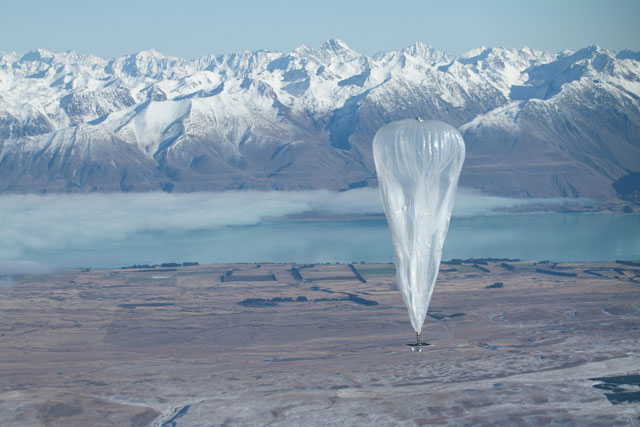
First it was self-driving cars, then Google Glass, and now with Project Loon, Google is turning its attention to … balloons. The company has begun a pilot project in New Zealand using high-pressure balloons in the stratosphere to provide Internet connectivity “at 3G speeds” and, if it goes well, Google wants to encircle the planet with them, with South Africa high on the list of planned countries that will run pilots.
Though the project may sound like something out of a science-fiction film, or like the ramblings of a madman — one of the motivations for its amusing name — Google is convinced the project is feasible.
Project Loon balloons will float about 19km above the earth’s surface, twice the altitude at which commercial aircraft fly and above unpredictable atmospheric weather systems. Each pumpkin-shaped balloon is the size of a light aircraft and is roughly 15m in diameter.
The superpressure balloons are designed to remain aloft for more than 100 days and travel around the earth on stratospheric wind currents. The direction and speed of the balloons will be controlled by raising or lowering them to different altitudes that correspond with different winds.
Users connect to the balloon network using an antenna attached their building. The balloons relay connectivity from terrestrial Internet networks and can share connectivity between them. Consistent connectivity is provided by ensuring that as a balloon moves out of range, another takes it place.
Because the balloons can share and distribute connectivity between them — acting as an airborne mesh network — it will also be possible to share connectivity from other regions if the terrestrial network in the coverage area is interrupted. This makes them ideally suited to providing connectivity in times of crisis.
In theory, this also means Google could provide connectivity across an entire degree of latitude with a sufficiently large number of balloons. The company says the project depends on support from existing terrestrial service providers and isn’t intended to replace them.
Each balloon is capable of serving an area with a 20km radius and a couple of hundred simultaneous users.
Mike Cassidy, a project leader for Loon and director of product management at Google[x] — the part of the company that’s home to its self-driving cars and to Project Glass — says the idea is inspired by the fact that two-thirds of the world’s population don’t yet have access to the Internet.
In addition to the terrestrial challenges presented by difficult terrain or inadequate network infrastructure, Cassidy says in many countries, particularly those in the southern hemisphere, a reliable Internet connection costs more than an average monthly income.
The Project Loon balloons communicate with one another and with the ground using unlicensed radio spectrum in the 2,4GHz and 5,8GHz bands.
Because the balloons are deployed at an altitude far lower than satellites — which are around 200km above the ground and higher — Cassidy says the connectivity they provide isn’t subject to the sort of high latency (the amount of time it takes a packet of data to make a round trip) that dogs satellite connectivity.
Although Google isn’t willing to disclose how much it’s spending on Project Loon or how much each balloon costs, Cassidy says the balloons are “relatively inexpensive” and a fraction of the cost of satellites or high-altitude platforms like tethered blimps.
Cassidy says one of key breakthroughs in conceptualising Project Loon was deciding that the balloons needn’t be tethered and would be allowed to move. Keeping them in fixed positions would have required fuel to power propellers or other solutions that would limit how much time they could spend aloft and would affect the cost.
Each balloon is, however, equipped with a small propeller to add air to the balloons to adjust their altitude. “There’s a propeller that allows us to add air to make the balloons drop,” he says. This may sound counterintuitive, but that adding air makes the balloon descend due to the “rules of buoyancy”.
Conversely, a valve allows air to be released if the balloon needs to be elevated. The balloons are made of polyethylene plastic roughly 0,08mm thick, and include solar panels to power them. The antennae, onboard computer and other electronic components are positioned beneath the solar panels.
While each balloon includes a parachute in case of emergency, Cassidy says they can be brought back to earth with precision by forcing them to perform a controlled descent.
The reason for using superpressure balloons is that even at night when temperatures drop, the pressure within them doesn’t fall sufficiently to alter their altitude. Cassidy explains that the balloons are only 5% full at launch but that the gas inside them expands as they get higher.

Google uses wind data from the US National Oceanic and Atmospheric Administration to calculate potential flight paths for the balloons and uses its vast computing power to control the balloons in groups in order to provide consistent connectivity.
As part of the trial, which will service 50 locations in and around Christchurch in New Zealand, Google launched a total of 30 balloons last week. Fibre backhaul from the ground station is being supplied by Research and Education Advanced Network New Zealand (Reanzz), which operates a high-speed broadband network for the New Zealand education, research and innovation communities.
Cassidy says New Zealand provides an excellent testing ground because outside of the cities, connectivity is often poor, a common problem in developing markets. “Over time we’d like to set up pilots in countries at the same latitude as New Zealand,” he says. “We’re looking at a band around 40 degrees and would naturally work north from there.”
Does this mean South Africa could see a Project Loon trial? “We do want to reach South Africa in our trials,” Cassidy says. “We hope to include South Africa, Uruguay and other South American countries in our trial as soon we expand it.”
Directing the balloons requires enormous computational power, something in which Google is well versed, and although the bulk of the balloons’ processes are automated, there remains an element of human control, especially during the testing phase.
It’s not hard to imagine the potential uses for the sort of network Google is proposing when it comes to mobile devices. “We imagine someday you’ll be able to use your cellphone with your existing service provider to connect to the balloons and get connectivity where there is none today,” Cassidy says. — (c) 2013 NewsCentral Media




